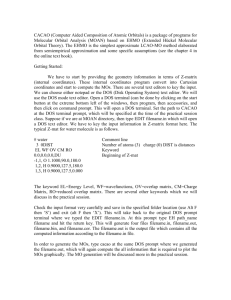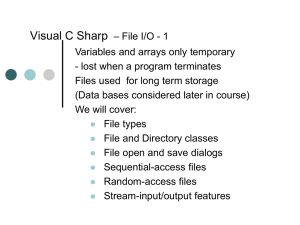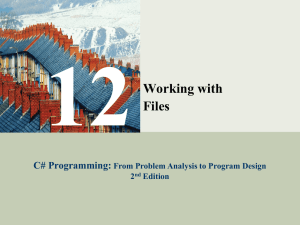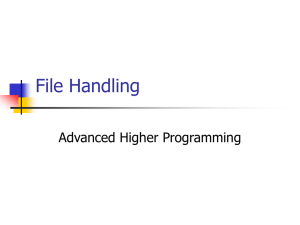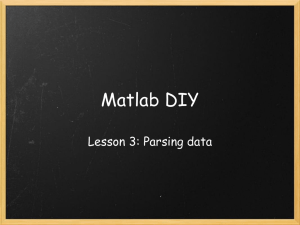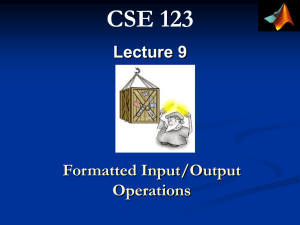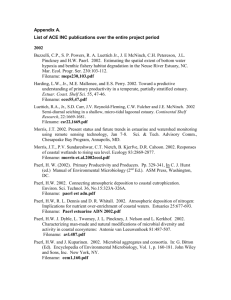C# Files and Streams: File I/O Presentation
advertisement
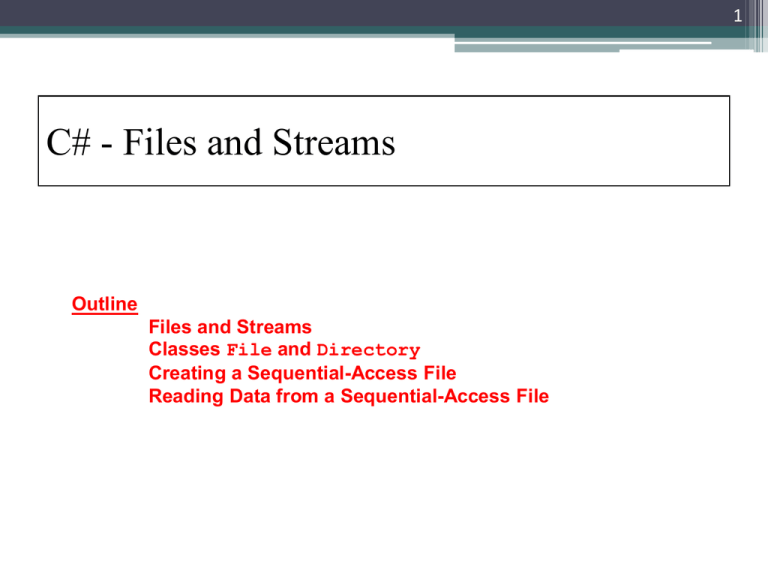
1
C# - Files and Streams
Outline
Files and Streams
Classes File and Directory
Creating a Sequential-Access File
Reading Data from a Sequential-Access File
2
Files and Streams
• When file opened C#:
▫ Creates an object
▫ Associates a stream with that object
Three stream objects:
Console.In: returns standard input stream object
Console.Out: returns standard output stream object
Console.Error: returns standard error stream object
• Namespace System.IO needed for file
processing
3
Files and Streams
• System.IO.Stream: allows representation of
stream as bits
▫ FileStream: read to and write from sequentialaccess and random-access files
▫ MemoryStream:transfer of data directly to and from
memory
▫ BufferedStream: uses buffer to transfer to
memory
4
Classes File and Directory
• Information stored in files
▫ Files organized in directories
Directory class used to manipulate
directories
▫ File class used to manipulate files
Only has static methods, cannot instantiate
File objects
5
// get user-specified file or directory
string fileName = ???
Set fileName to
what user typed
// determine whether fileName is a file
if ( File.Exists( fileName ) )
{
See if fileName is
an existing file
// obtain reader and file contents
try
{ StreamReader stream = new StreamReader( fileName );
Create
string inputString = stream.ReadToEnd();
StreamReader to
read text from file
}
// handle exception if StreamReader is unavailable
Call method
catch( IOException )
{
}
}
MessageBox.Show( "File Error", "File Error",
MessageBoxButtons.OK, MessageBoxIcon.Error );
ReadToEnd
6
else
{
// notify user that neither file nor directory exists
MessageBox.Show( filename + " does not exist", "File Error",
MessageBoxButtons.OK, MessageBoxIcon.Error );
}
} // end if
FileTest.cs
If user input is not
existing file output error
message
7
SaveFileDialog
// create dialog box enabling user to save file
8
Instantiate
SaveFileDialog object
SaveFileDialog fileChooser = new SaveFileDialog();
DialogResult result = fileChooser.ShowDialog();
Show SaveFileDialog
// allow user to create file
fileChooser.CheckFileExists = false;
// exit event handler if user clicked "Cancel“
if ( result != DialogResult.Cancel )
{
Test if user
canceled save
// get specified file name
string fileName = fileChooser.FileName;
// show error if user specified invalid file
if ( fileName == "" || fileName == null )
MessageBox.Show( "Invalid File Name", "Error",
MessageBoxButtons.OK, MessageBoxIcon.Error );
Get file name
to save to
9
else
{
// save file via FileStream if user specified valid file
try
Instantiate output stream
{
with write permission
// open file with write access
output = new FileStream( fileName, FileMode.OpenOrCreate, FileAccess.Write );
}
// notify user if file does not exist
catch ( FileNotFoundException )
{
MessageBox.Show( "File Does Not Exist", "Error",
MessageBoxButtons.OK, MessageBoxIcon.Error );
}
}
Method to save data
when user clicks enter
10
Creating or Writing to a SequentialAccess File
• Programmers have to structure files to meet the
requirements of applications
• Declare and define a record class which describes
the structure of the data
• Write the main class to write out a record
11
Libraries Needed to read a file
sequentially
using System;
using System.IO;
using System.Runtime.Serialization.Formatters.Binary;
using System.Runtime.Serialization;
12
[Serializable]
public class Record
{
private int account;
private string firstName;
private string lastName;
private double balance;
Tells compiler objects of class Record
can be represented as a set of bytes
Data to go into record
// set members to default values
public Record() : this( 0, "", "", 0.0 )
{ }
Sets members to 0
13
// set members to parameter values
public Record( int accountValue, string firstNameValue,
string lastNameValue, double balanceValue )
{
Account = accountValue;
FirstName = firstNameValue;
Set members to
parameters
LastName = lastNameValue;
Balance = balanceValue;
} // end constructor
14
// property Account
public int Account
{
get
{ return account; }
set
Record.cs
{ account = value; }
} // end property Account
} //end class
Other properties
and methods
15
Main class
// Creating a sequential-access file of records
// C# namespaces
using System.IO;
using System.Runtime.Serialization.Formatters.Binary;
using System.Runtime.Serialization;
// serializes Record in binary format
private BinaryFormatter formatter = new BinaryFormatter();
// stream through which serializable data is written to file
private FileStream output;
16
// Record containing TextBox values to serialize
Record record = new Record();
// store values in Record and serialize Record
try
{
record.Account = Int32.Parse(
values[ ( int )TextBoxIndices.ACCOUNT ] );
record.FirstName = values[ ( int )TextBoxIndices.FIRST ];
record.LastName = values[ ( int )TextBoxIndices.LAST ];
record.Balance = Double.Parse( values[ ( int )TextBoxIndices.BALANCE ] );
Store TextBox
fields in
record
// write Record to FileStream (serialize object)
formatter.Serialize( output, record );
}
Write data to file
17
// notify user if error occurs in serialization
catch( SerializationException )
{
MessageBox.Show( "Error Writing to File", "Error",
MessageBoxButtons.OK, MessageBoxIcon.Error );
}
Catch block if user
input invalid data
// notify user if error occurs regarding parameter format
catch( FormatException )
{
MessageBox.Show( "Invalid Format", "Error",
MessageBoxButtons.OK, MessageBoxIcon.Error );
}
}
Close FileStream
18
Don’t forget to close the output file!
// invoked when user clicks Exit button
private void exitButton_Click( object sender, System.EventArgs e )
{
// determine whether file exists
if ( output != null )
{
// close file
try
{
output.Close();
}
19
Reading Data from a Sequential-Access File
• Read data sequentially from a file
▫ Programs usually start at beginning of file and read
data consecutively until the desired data is found
Sometimes necessary to do this several times during
execution of a program
▫ File-position pointer:
Points to next byte to be read from or written to file
Can be repositioned to any point in file
// invoked when user clicks Open File button
20
User clicked open button
private void openButton_Click(
object sender, System.EventArgs e )
{
// create dialog box enabling user to open file
OpenFileDialog fileChooser = new OpenFileDialog();
Instantiate OpenFileDialog
DialogResult result = fileChooser.ShowDialog();
// exit event handler if user clicked Cancel
if ( result != DialogResult.Cancel )
{ // get name from user
fileName = fileChooser.FileName;
// show error if user specified invalid file
if ( fileName == "" || fileName == null )
MessageBox.Show( "Invalid File Name", "Error",
MessageBoxButtons.OK, MessageBoxIcon.Error );
Show
OpenFileDialog
21
// read and display file information
try
{
// close file from previous operation
if ( input != null )
input.Close();
// create FileStream to obtain read access to file
input = new FileStream( fileName, FileMode.Open, FileAccess.Read );
// traverse file until end of file
while ( true )
{
22
While loop to read from
file
// get next Record available in file
Record record = ( Record )reader.Deserialize( input );
// display record
Read input
from file
string output = record.Account + "\t" +
record.FirstName + "\t" + record.LastName +
new string( ' ', 6 ) + "\t";
// display balance with correct monetary format
output += String.Format(
"{0:F}", balance ) + "\r\n";
// copy output to screen
displayTextBox.Text += output;
}
23
// handle exception when no more records
catch( SerializationException )
No more records
exception
{
// close FileStream if no Records in file
input.Close();
}
Close FileStream
